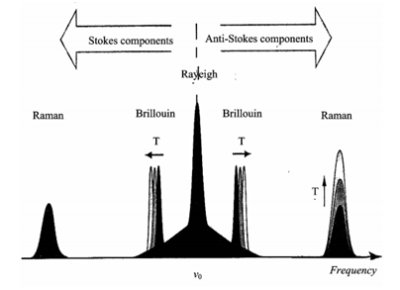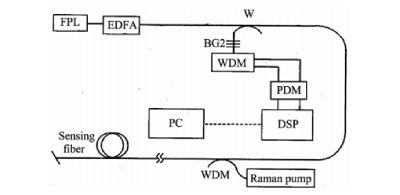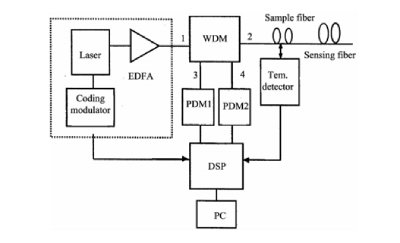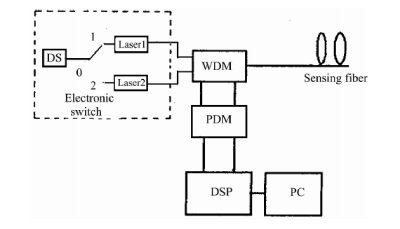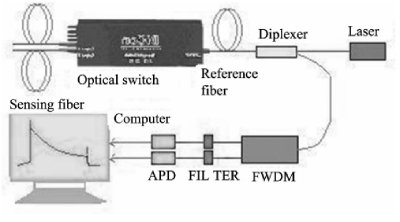The applications of Raman WDM
Distributed optical fiber sensing technology
Optical fiber sensing technology is a new type of sensing technology that developed rapidly with the development of optical fiber communication technology in the 1970s. It uses light waves as a carrier and optical fiber as a medium to sense and transmit external measured signals. Compared with conventional sensors, optical fiber sensors have many advantages such as high measurement sensitivity, anti-electromagnetic interference, anti-radiation, high pressure resistance, corrosion resistance, small size, light weight, and adaptation to harsh environments. The optical fiber component itself is both a detection element and a transmission element , which can connect many optical fiber sensing units on the optical fiber trunk to form a large-scale remote sensing system for distributed monitoring and measurement.
Distributed optical fiber sensing technology has the ability to extract the distribution information of a large range of measured fields, and can solve many problems in the current measurement field. Therefore, it has huge application potential. With more than 30 years of research, a series of sensing mechanisms and measurement systems have been produced. Distributed optical fiber sensing technology has made considerable development, and three breakthroughs have been made in the following aspects: (1) Distributed optical fiber sensing technology based on Rayleigh scattering; (2) Distributed optical fiber transmission based on Raman scattering Sensing technology; (3) Distributed optical fiber sensing technology based on Brillouin scattering. Distributed optical fiber sensing technology based on Rayleigh scattering is commonly used to detect the breakpoint and attenuation characteristics of optical fibers. Distributed optical fiber sensing technology based on Raman scattering is mainly used for temperature measurement. These two technologies have become mature and have been Practical. The distributed optical fiber sensing technology based on Brillouin scattering can realize the simultaneous measurement of temperature and strain, and has high measurement accuracy and spatial resolution. With the advantages of anti-electromagnetic interference, long-distance monitoring, and high sensitivity, this technology has been widely used in composite overhead ground wire (OPGW) and all-dielectric self-supporting (ADSS) fiber optic cable monitoring, and temperature monitoring of oil and gas pipeline leakage, high-voltage equipment in power plants, substations, and high-voltage cables, and health diagnosis of large concrete structures.
Principle
We will introduce several applications of Raman WDM devices in the Raman scattering distributed optical fiber sensing technology. First, let's talk about the principle of Raman scattering distributed optical fiber sensing technology.
Fig 1. Spectrum of Rayleigh scattering, Brillouin scattering and Raman scattering
A beam of light injected into the optical fiber will produce three kinds of scattered light with different frequency shifts, Rayleigh scattering, Brillouin scattering and Raman scattering. The spectrum of the three kinds of scattered light in the optical fiber is shown in Figure 1. Rayleigh scattering in an optical fiber is a kind of elastic light scattering. The wavelength of the scattered light is equal to the wavelength of the incident light without frequency change.
The optical time domain reflectometer (OTDR) designed by using the principles of Rayleigh scattering and optical time domain reflection can be used for the measurement of optical fiber parameters. The essence of Brillouin scattering in optical fiber is the inelastic scattering of the interaction between incident light and acoustic phonons. The spectral frequency shift of Brillouin scattering is 11GHz. The fiber optic strain sensors developed based on fiber Brillouin scattering have been used in practical engineering projects. The Raman scattering is the interaction between incident light and optical phonons of the fiber itself. Either absorb phonons and convert them into higher frequency scattered light or emit phonons to convert into scattered light with a lower frequency.
Application examples
Example 1: Distributed optical fiber Raman temperature sensor (DTS) integrated optical fiber Raman amplifier
Fig.2
The remote distributed optical fiber Raman photon temperature sensor system with integrated optical fiber Raman amplifier is based on the fusion principle of optical fiber stimulated Raman scattering and optical fiber anti-Stokes Raman scattering and the principle of wavelength division multiplexing. It combines the characteristic of optical fiber, the amplification principle of fiber stimulated Raman scattering, and the principle that the intensity of the anti-Stokes Raman scattered wave of an optical fiber is modulated by the temperature of the optical fiber, and the principle of optical time domain reflection. The pump fiber laser is connected to a 1×2 fiber bidirectional coupler through a pump-signal fiber wavelength division multiplexer, and one end is connected to a 50km fiber.
The reverse Rayleigh scattered light, Stokes and anti-Stokes Raman scattered light of the optical fiber are connected to the fiber grating narrow-band reflection filter through the other end of the optical fiber 1×2 duplex coupler. And the Stokes light and anti-Stokes Raman scattered light coarse wavelength division multiplexer is connected to the avalanche photodiode (APD) , and the distributed optical fiber temperature sensor integrated with the optical fiber Raman amplifier is converted into analog electrical signals and performed enlarge. Measure the intensity ratio of the two, and obtain the temperature information of each point of the fiber.
Example 2: Distributed optical fiber Raman temperature sensor (DTS) using pulse coding technique
Fig.3
The distributed optical fiber Raman temperature sensor using pulse encoding and decoding is shown in Figure 3. The sensor encodes and decodes the signal based on S matrix conversion, and uses the effect of temperature modulation of the optical fiber Raman light intensity and the principle of optical time domain reflection for optical fiber online positioning and temperature measurement. Including fiber-coupled high-speed multi-pulse laser transmitter, integrated fiber wavelength division multiplexer, fiber temperature sampling loop, intrinsic temperature measurement fiber, two photoelectric receiving and amplifying modules, codec and demodulation digital signal processor, digital temperature Detector and PC. The sensor uses a novel sequence of multi-bit laser pulse encoding and decoding technology, which can obtain a better signal-to-noise ratio under the same measurement time, and increase the number of emitted photons. The spatial resolution can be improved by narrowing the laser pulse width. The reduction of the peak power requirement of the laser pulse can effectively prevent the nonlinear effect of the fiber.
Example 3:Diagram of distributed optical fiber Raman temperature sensor (DTS) using self-correction technique
Fig.4
Raman-related dual-wavelength light source self-correcting distributed optical fiber Raman temperature sensor includes Raman-related dual-wavelength fiber pulse laser module (composed of drive power, electronic switch, main laser and auxiliary laser), integrated optical fiber wavelength division multiplexer , two photoelectric receiving and amplifying modules, digital signal processor, display and intrinsic temperature measuring fiber.
The integrated wavelength division multiplexer has five ports, of which the input port 1 and port 2 are respectively connected to the Raman-related dual-wavelength main laser 1550nm fiber pulse laser and the auxiliary laser 1450nm fiber pulse laser. The port 3 of the device are connected to the intrinsic temperature measurement fiber, and the output port 4 (1450nm port) is connected to the first photoelectric receiving and amplifying module. The output port 5 (1550nm port) is connected to the second photoelectric receiving and amplifying module. The first and the second end of the photoelectric amplify module are connected to the digital signal processor, and the signal output end of the digital signal processor is connected to the display.
Example 4:Distributed optical fiber temperature sensor embedded optical switch
Fig.5
Using the time division multiplexing characteristics of the optical switch for light, a 1×4 optical switch is embedded in the distributed optical fiber Raman temperature sensor system, and the temperature measurement fiber is expanded from the original one to four, as shown in Figure 5. It can effectively extend the total temperature measurement fiber length of the distributed fiber Raman temperature sensor system.
Trends of development
In recent years, the fire safety situation in tunnels, cables, oil pipelines and coal mines has been very severe. In 2011, the State Council promulgated the National Comprehensive Disaster Prevention and Mitigation Plan (2011-2015), which requires the strengthening of disaster monitoring and early warning capabilities. The Ministry of Science and Technology has issued the "Twelfth Five-Year Plan for the Development of National Disaster Prevention and Mitigation Science and Technology", which focuses on major disaster optical fiber sensing monitoring and early warning technology. The standards issued in the transportation, power, petrochemical and other industries all mandate and clearly stipulate the installation of linear fire monitors in traffic tunnels, cable tunnels, and oil pipes. All of these provide a good external environment for the distributed optical fiber Raman temperature sensor to play a greater role, and the application of various major projects is also showing a rapid growth trend.
HYC can provide various customized Raman WDMmodules, with mature production technology, stable and reliable performance, and stable signal transmission. HYC has 20 years of experience in the production and manufacturing of passive optical devices, and has 6 core technology platforms: FA fiber array design and manufacturing technology, precision mold injection design and manufacturing technology, optical passive device coupling packaging technology, chip packaging and testing technology, pull Cone design and manufacturing technology, low-frequency circuit design technology. HYC layouts lean production, adhere to high-efficiency and high-quality output, invest in various sophisticated automated production testing equipment, and continuously improve production capacity to meet customer diversified solution needs.
[1]Wangjianfeng,WANG, jian-feng,[New type distributed optical fiber temperature sensor (DTS) based on Raman scattering and its' application],Spectroscopy & Spectral Analysis , 2013,(33):865-871
